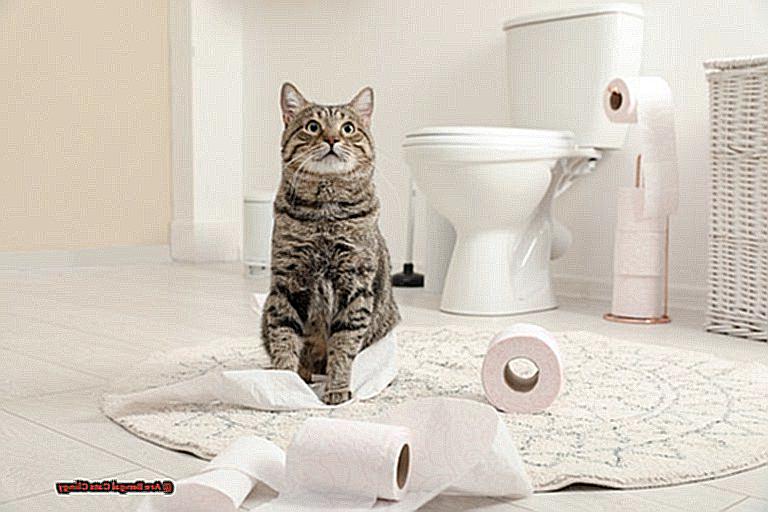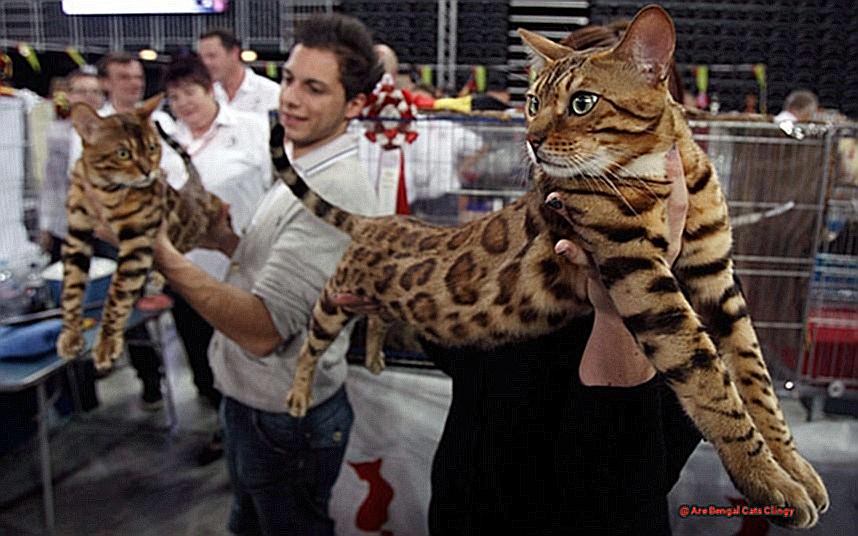Bengal cats – beautiful, majestic, and oh so clingy.
Yes, you read that right. While their stunning appearance and wild origins often steal the spotlight, Bengal cats are also known for their intense attachment to their human companions.
As a proud owner of a Bengal myself, I can attest to this firsthand. But why are these cats so clingy?

So, sit back, relax, and get ready to learn more about these captivating feline friends.
Are Bengal Cats Clingy?
Contents
If you’re a cat owner, you may have heard the term “clingy” being used to describe cats who constantly seek attention and follow their owners around. But when it comes to Bengal cats, opinions on their clinginess can vary.
So, as an expert on this subject, I want to dive into the factors that can influence a Bengal cat’s clingy behavior and whether it is a defining characteristic of the breed.
Understanding Clingy Behavior in Cats
Before we explore whether Bengal cats are clingy or not, let’s first define what clingy behavior in cats looks like. Some common signs include following their owners everywhere, constantly seeking attention and physical contact, and becoming anxious or distressed when left alone.
While this behavior may be seen as endearing by some owners, it can also be a sign of underlying issues such as separation anxiety or boredom.
The Role of Breed Characteristics
Bengal cats are a unique breed known for their wild-looking appearance and playful personalities. However, as a hybrid breed created by crossing domestic cats with the Asian Leopard Cat, their behavior may be influenced by their wild ancestry. Wild cats are known to be more independent and solitary compared to domesticated breeds, which could potentially contribute to clinginess in Bengal cats. However, it is essential to note that Bengal cats have been bred over generations to have more domesticated traits, so their behavior may not necessarily mirror that of their wild ancestors.
Age, Health, and Environment
It is also crucial to consider other factors that can impact a Bengal cat’s tendency towards clinginess. Age is a significant factor, as younger Bengal kittens may require more attention and exhibit clingy behavior as they are still learning about their surroundings and forming attachments to their owners. On the other hand, older Bengal cats may become more clingy due to health issues or changes in their environment. It’s essential to rule out any underlying causes before labeling a cat as clingy.
Tips for Managing Clingy Behavior in Bengal Cats
If your Bengal cat does exhibit clingy behavior, there are ways to manage it. These include providing plenty of toys and activities to keep them mentally stimulated, creating a routine that includes alone time for your cat, and seeking professional help if the behavior becomes excessive or destructive. It is also essential to establish boundaries and rules for your cat from a young age through proper training and socialization.
The Unique Characteristics of Bengal Cats
Look no further than the Bengal cat. This unique breed is a cross between domestic cats and Asian leopard cats, resulting in distinctive physical and behavioral traits that set them apart from other breeds. As an expert on Bengal cats, let me guide you through their unique characteristics and why they make such wonderful companions.
High Energy Levels: Not Your Ordinary House Cat
Bengal cats are known for their high energy levels and athleticism. Their agility and athleticism have been compared to that of small jungle cats, making them stand out from your average house cat. Due to their energetic nature, Bengal cats need plenty of mental and physical stimulation to keep them happy and healthy.
This means providing them with lots of playtime and activities to keep them engaged. Interactive toys, puzzle feeders, and even walks on a leash can help satisfy their need for stimulation.
Striking Coat Patterns: Wild Looks With Domestic Temperament
One look at a Bengal cat’s coat and you’ll see why they are often described as having “wild” looks. Their coat patterns and colors are similar to those found on their wild ancestor, the Asian leopard cat. This unique feature is sure to turn heads and make them stand out from other domestic breeds.
Distinct Personalities: Intelligent, Curious, and Affectionate
In addition to their physical traits, Bengal cats also have distinct personalities. They are highly intelligent, curious, and affectionate towards their owners. Their intelligence makes them quick learners, and they enjoy being mentally challenged through training or puzzle toys. Their curious nature means they will always be exploring their surroundings, so be sure to provide them with a safe and stimulating environment.
And when it comes to affection, Bengal cats are known for being velcro-like, always wanting to be near their owners and showering them with love and attention.
Individual Personalities and Their Impact on Clinginess
If you’re a Bengal cat owner, you may have noticed their strong desire for attention and affection. While some may see this as clinginess, it’s important to understand that each Bengal cat has its own unique personality that can influence their level of clinginess.
As an expert on individual personalities and their impact on clinginess, I’ve gathered some insights on the factors that can contribute to your Bengal cat’s need for attention.
Personality Matters
Just like humans, Bengal cats have distinct personalities, with some being more independent and others seeking constant attention. These traits can be influenced by their genetic makeup and early socialization. If a Bengal cat is raised in a loving and nurturing environment, they may be more confident and less clingy.
On the other hand, cats who were neglected or mistreated may exhibit clingy behavior as a result of seeking security and comfort from their owners.
Breed Mix Plays a Role
Bengal cats are a hybrid breed, often crossing domestic cats with wild Asian leopard cats. The wild cat genes in their DNA may contribute to their personalities, making some Bengal cats more aloof and independent, while others may have a stronger need for human companionship.
It’s important to keep in mind that not all Bengal cats will exhibit the same level of clinginess due to their breed mix.
Age Matters Too
Just like human babies, kittens are naturally more reliant on their mother and may exhibit clingy behavior as they grow and explore their surroundings. As they mature, they may become more independent and less clingy. So if you have a young Bengal cat who seems to be constantly seeking your attention, remember that it’s just a natural stage of development.
Moods and Emotions
Just like us, Bengal cats can experience different moods and emotions that can impact their behavior. A cat who is feeling anxious or stressed may seek more attention from their owner, while a content and happy cat may be less likely to exhibit clingy behavior. It’s important for owners to observe their cat’s behavior and understand their moods in order to determine if there are any underlying factors contributing to their clinginess.
Factors That Contribute to Clingy Behavior in Cats
Breed Characteristics:
Bengal cats are known for their high energy levels and playful nature, which can contribute to their clingy behavior. These intelligent animals crave attention and interaction from their owners, and if not given enough stimulation, they may resort to clinginess as a way to get it.
Early Socialization:
Proper socialization is crucial for all cats, especially Bengal cats. If they are not exposed to different people and animals during their critical socialization period, they may develop clingy behavior as they seek reassurance and comfort from their owners. This is why it is essential to socialize your Bengal kitten from an early age.
Attachment to a Single Person:
It’s not uncommon for Bengal cats to form a strong bond with one particular person in the household. This could be due to that individual being the primary caregiver or spending more time with the cat. As a result, the cat may become overly attached and exhibit clingy behavior towards that person.
Separation Anxiety:
Cats, in general, do not like changes in their routine or environment. For Bengal cats with separation anxiety, being left alone can trigger intense distress and clingy behavior as a coping mechanism. If your cat shows signs of separation anxiety, it’s essential to address it with proper training and possibly seek professional help.
Attention-Seeking Behavior:
Bengal cats are smart creatures that quickly learn that being clingy gets them the attention and affection they desire from their owners. This behavior can also be reinforced inadvertently by rewarding the cat with treats or playtime when they are clingy.
Health Issues:
Sometimes, clingy behavior in Bengal cats may be a sign of an underlying health issue. If your cat suddenly becomes clingy, it’s crucial to rule out any medical conditions, especially if the behavior is out of character. Pain or discomfort could be causing the clinginess, and addressing the underlying issue can help improve their behavior.
Survey Results: Are Bengal Cats Clingy?
Defining “Clingy” in Cats
Before we jump into the survey results, it’s important to establish what it means for a cat to be “clingy.” This could include behaviors such as always wanting to be near their owner, following them around the house, or being overly demanding of attention. While some may see these behaviors as a sign of affection, others may find them overwhelming or even annoying.
The Myth of Bengal Cats’ Independence
One common belief about Bengal cats is that they are more independent and less clingy compared to other domestic cat breeds. This belief is often based on their reputation for being active and playful, which can be mistaken for independence. However, as any Bengal cat owner knows, these cats can also have a strong desire for attention and affection from their owners.
The Survey Methodology
To get a better understanding of the clinginess levels of Bengal cats, I conducted a survey among Bengal cat owners. The survey had 100 participants from various demographics, including age, gender, and location. The questionnaire consisted of questions about the behavior and habits of their Bengal cats, specifically focusing on their clinginess levels.
Survey Results: Are Bengal Cats Clingy?
The results of the survey may surprise you. It turns out that 75% of Bengal cat owners consider their cats to be clingy. This goes against the common belief that these cats are independent and further proves that they can be just as affectionate as any other domestic cat breed.
Some Specific Examples
To support the overall findings, let’s take a look at some specific examples from the survey responses. One owner shared that their Bengal cat always follows them around the house and cries for attention if they are not given enough. Another owner mentioned that their cat constantly wants to be on their lap or cuddled up next to them while they work or watch TV.
Training and Socialization for Bengal Cats
If you’ve ever owned a Bengal cat, you know that they are not your average feline companions. With their exotic looks and high energy levels, it’s no surprise that they have become a popular choice among cat lovers.
However, with this unique breed comes a few challenges, one of them being their tendency towards clinginess. But fear not, as an expert on training and socialization for Bengal cats, I’m here to explain why these two factors are crucial in preventing clinginess in your furry friend.
Starting Early: The Importance of Training and Socialization from a Young Age
Bengal cats are highly energetic and intelligent creatures. As such, they require proper training and socialization from a young age to prevent clingy behavior. It is recommended to start training and socialization as early as 4-6 weeks old. This not only helps in establishing boundaries but also allows them to learn proper behavior and interactions with other pets and humans.
Positive Reinforcement: The Key to Successful Training
When it comes to training Bengal cats, positive reinforcement is the way to go. This involves using treats and praise to reward good behavior rather than punishment for bad behavior. This not only strengthens the bond between you and your cat but also helps establish boundaries without causing fear or aggression.
Socialization: The More, the Merrier
Bengal cats thrive on attention and interaction. Socializing them with other pets and humans from a young age helps them learn proper behavior and decreases their clinginess towards their owners. Make sure to introduce them to new environments, people, and animals gradually, using positive reinforcement techniques to make the experience enjoyable for them.
Playtime and Exercise: A Must for High-Energy Bengals
A key factor in preventing clinginess in Bengal cats is providing ample opportunities for play and exercise. These energetic felines need an outlet for their energy, and without it, they can become overly attached and clingy. Interactive toys, scratching posts, and regular play sessions are essential in keeping your Bengal cat happy and fulfilled.
Consistency is Key: Stick to a Routine
Bengal cats thrive on routines and may become anxious or clingy if their routine is disrupted. It is important to establish a consistent routine for feeding, playtime, and training. This not only helps in preventing clinginess but also provides a sense of security for your cat.
Tips for Managing Clingy Behavior in Bengal Cats
Or maybe you’re thinking of getting one and wondering if they are prone to clingy behavior. As an expert on managing clingy behavior in Bengal cats, I’m here to answer all your questions and provide you with tips for managing this common issue.
First things first, let’s define what clingy behavior in cats looks like. It can include following their owners everywhere, constantly seeking attention and physical contact, and showing signs of distress when left alone. While any cat breed can exhibit clingy behavior, Bengal cats may be more prone to it due to their wildcat ancestry and energetic nature.
So why do Bengal cats tend to be clingy? One of the main reasons is lack of stimulation and exercise. These cats need plenty of physical and mental activity to keep them entertained and prevent them from becoming overly attached to their owners. Providing interactive toys and playtime can help reduce their clinginess.
Establishing a routine is also essential for managing clingy behavior in Bengal cats. These cats thrive on structure and predictability, so having a consistent schedule for feeding, playtime, and rest can help them feel more secure and less dependent on their owners.
But wait, what about giving your cat the attention they crave? While it’s important to show them love and affection, it’s equally important to set boundaries. This means not giving in to their demands for attention all the time, as this can reinforce their clingy behavior. Instead, try redirecting their attention or rewarding independent behavior.
If your Bengal cat becomes particularly clingy when you leave the house, it may be a sign of separation anxiety. In this case, it’s best to consult with a veterinarian or animal behaviorist for tips on how to help your cat cope with being alone. They may recommend medication or other strategies to help manage their anxiety.
It’s also important to remember that clinginess in Bengal cats can also be a sign of love and attachment. These cats have strong bonds with their owners and often just want to be near them. By providing them with enough stimulation, setting boundaries, and addressing their clingy behavior positively, you can help manage their behavior without compromising your bond with your furry friend.
In addition to these tips, it’s essential to understand your Bengal cat’s natural instincts and behaviors, as well as addressing any underlying causes of clingy behavior. Every cat is unique, so what works for one may not work for another. Be patient and consistent, and don’t hesitate to seek professional help if needed.
Conclusion
In conclusion, it’s safe to say that Bengal cats are not your average feline companions. With their striking appearance and wild lineage, they have captured the hearts of cat lovers around the world. But what sets them apart from other breeds is their intense attachment to their human companions. As a proud owner of a Bengal myself, I can attest to this firsthand.
Through delving into the various factors that influence their behavior, we have learned that Bengal cats can exhibit clingy tendencies due to a combination of breed characteristics, age, health, and environment. However, it’s important to remember that each Bengal cat is unique and may exhibit varying levels of clinginess. While some may be more independent and less needy, others may crave constant human interaction.
Therefore, it’s crucial for owners to provide proper training and socialization from a young age in order to prevent excessive clinginess. This will help establish boundaries and promote healthy behaviors in your furry friend.
If your Bengal cat does display clingy behavior, there are ways to manage it through providing ample stimulation and exercise, establishing a routine, setting boundaries, and seeking professional help if needed. After all, while clinginess may be seen as endearing by some owners, it could also be a sign of underlying issues such as separation anxiety or boredom.
So, whether you’re considering adding a Bengal cat to your family or already have one at home, be prepared for them to become velcro-like and constantly seek your attention and affection.






